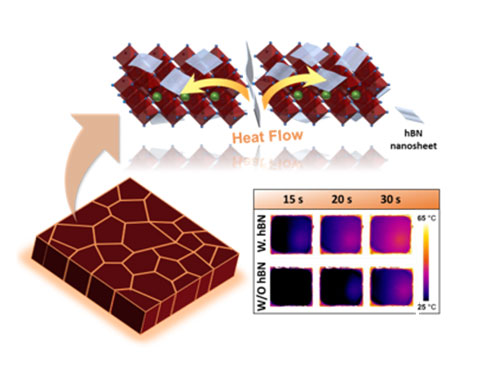Nanosheets Increase Perovskite Solar Cell Efficiency and Stability
April 30, 2024
 enlarge
enlarge
2D hBN nanosheets integrated into the hybrid perovskite solar cells enabled an enhanced crystallization by efficient heat distribution, resulting in improved efficiency and stability.
Scientific Achievement
CFN scientists and users from Stony Brook University collaborated to discover that adding 2D hexagonal boron nitride nanosheets to perovskite solar cells expedites crystallization and grain growth, improving the cells' efficiency and stability in air.
Significance and Impact
Improving solar cell efficiency from 17.4% to 19.8%, with 90% efficiency post-500 hours in ambient air, shows the potential of hBN additives in organic and perovskite device design.
Research Details
- Controlling crystallization and grain growth is crucial for realizing highly efficient hybrid perovskite solar cells (PSCs).
- Enhanced performance and stability of a PSC was achieved by accelerating perovskite crystallization and grain growth via 2D hexagonal boron nitride (hBN) nanosheet additives incorporated into the active perovskite layer.
- In situ X-ray scattering and infrared thermal imaging during the perovskite annealing process revealed the highly thermally conductive hBN nanosheets promoted the phase conversion and grain growth in the perovskite layer by facilitating a more rapid and spatially uniform temperature rise within the perovskite film.
- Complementary structural, physicochemical, and electrical characterization further showed that the hBN nanosheets formed a physical barrier at the perovskite grain boundaries and the interfaces with charge transport layers, passivating defects and retarding ion migration.
- The power conversion efficiency of the PSC was improved from 17.4% to 19.8%, along with enhanced device stability, retaining ≈90% of the initial efficiency even after 500 h ambient air storage.
- The results not only highlight 2D hBN as an effective additive for PSCs but also suggest enhanced thermal transport as one of the pathways for improved PSC performance by 2D material additives in general.
- In situ X-ray scattering and thermal imaging during annealing showed that hBN promotes uniform temperature distribution, facilitating grain growth and phase conversion.
- CFN Advanced UV & X-ray Probes, Electron Microscopy, Nanofabrication, and Materials Synthesis facilities were used.
Publication Reference
Y. Yin, Y. Zhou, S. Fu, X. Zuo, Y.-C. Lin, L. Wang, Y. Xue, Y. Zhang, E. Tsai, S. Hwang, K. Kisslinger, M. Li, M. Cotlet, T.-D. Li, K.G. Yager, C.-Y. Nam, M.H. Rafailovich, "Enhancing Crystallization in Hybrid Perovskite Solar Cells Using Thermally Conductive Two-Dimensional Boron Nitride Nanosheet Additive", Small 19, 15 (2023).
OSTI: www.osti.gov/biblio/1958563
Acknowledgment of Support
This research used Materials Synthesis and Characterization, and Electron Microscopy Facilities of the Center for Functional Nanomaterials (CFN) and the Complex Materials Scattering (CMS) beamline of the National Synchrotron Light Source II (NSLS-II, in partnership with CFN), which are a U.S. Department of Energy Office of Science User Facilities, at Brookhaven National Laboratory under Contract No. DE-SC0012704. The research was also supported by the Office of Naval Research under Contract No. N000142012858. The authors acknowledge the use of the facilities at the Advanced Science Research Center (ASRC) at the City University of New York, and the Advanced Energy Research & Technology Center (AERTC) at Stony Brook University.
2024-21895 | INT/EXT | Newsroom









